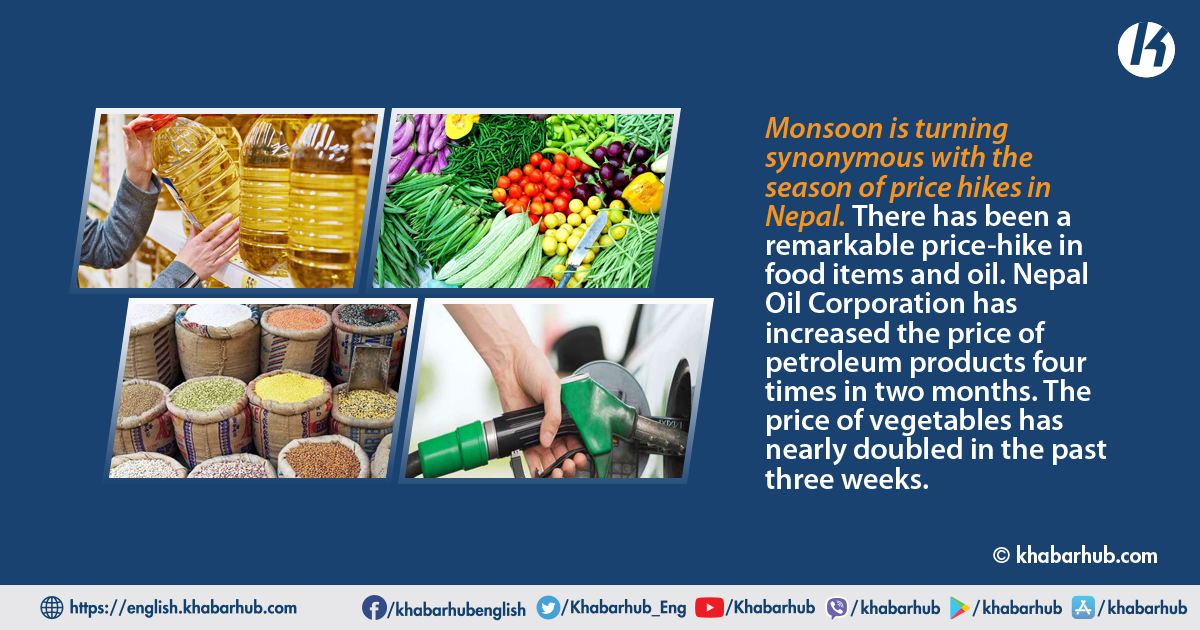0%

KATHMANDU: Nepal Oil Corporation (NOC) has been increasing the prices of petroleum products every 15 days as a price adjustment. After the enforcement of prohibitory orders to curb the second wave of coronavirus pandemic, the price of petrol, diesel, kerosene and aviation fuel had gone up for the first time on May 16.
After that, NOC increased the prices on June 5, June 23 and July 10.
Petrol has gone up by Rs 8 to become Rs 129, and kerosene has reached Rs 112 per liter since May 16. Cooking gas has increased by Rs 25 per cylinder to cost Rs 1,425. Domestic aviation fuel has increased by Rs 8 per liter and reached Rs 84. An increase in the price of petroleum fuel has impacts on all sectors.
NOC claims to be adjusting the price of oil as per the price hike in the international market and the list sent by the Indian Oli Corporation.
Vegetable price has gone more than threefold
Prices of vegetables have skyrocketed in the capital valley. The Kalimati Fruits and Vegetables Market Development Committee has stated that the prices of potatoes, cauliflower, green chilies, turnips and green vegetables have especially gone high.
According to Binaya Shrestha, an information officer of the committee, the supply of vegetables has decreased due to landslides blocking highways and declining production in the rainy season.
“Every year during the rainy season, there is a problem in transporting the vegetables. In this season, we have less vegetable production as well,” he said to Khabarhub.
According to the price list posted on the committee’s website, the price of vegetables has gone up by 40 percent to 350 percent in the past 24 days. Green chilies increased by Rs 60 from Rs 50 per kg on June 15 to Rs 110 on July 8. This is an increase of 120 percent. The price of Indian potato rose by 60 percent to Rs 45 per kg from Rs 28 per kg on June 15.
Similarly, squash increased by 133 percent from Rs 30 to Rs 45 per kg, while cauliflower increased by 75 percent from Rs 40 to Rs 70 per kg.
Green gourd increased by 350 percent from Rs 30 to Rs 90 per kg while bitter gourd rose by 180 percent from Rs 25 to Rs 70 per kg.
Food items also witnessed the price-hike
Prices of food items have also gone up during the prohibitory orders period. Comparison of the price list of April 20 and July 8, reveals that the prices of rice, sugar and oil have soared high.
According to the price list provided by Nepal Retail Trade Association, the price of Pokhreli rice of Trishuli has gone up by Rs 5 from Rs 85 per kg on April 20 to Rs 90 per kg on July 8.
Similarly, the price of sugar rose by Rs 5 per kg to become Rs 90 per kg. The Dalda ghee saw an increase by Rs 30 to become Rs 210 per kg. Roasted mustard oil has gone up by Rs 20 per liter from April 20’s price to become Rs 350 on July 8. The crude mustard oil price has increased by Rs 20 and has become Rs 240 per liter now.
The Supply-Demand game
According to Shivraj Sedhai, the director of the Department of Industry, Commerce, Supply and Consumer Protection, the price of items other than fuel and drinking water is determined by the producers and importers.
He clarified that in the case of other food items, the price is determined on the basis of the cost, quality, and profit of the product as per the law.
He took the price hike easily and said that the price of daily necessities might have gone up in the market due to the blockade of roads and supply even after the ban was lifted.
“When the road is blocked due to various reasons including the landslide and floods, there is a situation when the vegetables rot in the farmers’ fields and there is a shortage in the market,” he said, adding, “In such situations, one has to consider the demand, supply and price factors relatively; however, if we find the unlawful and abnormal price-hike, we will take due action.”